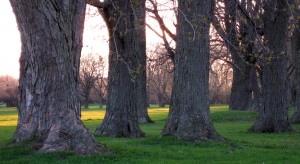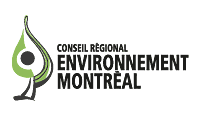by Sally Cole
The lawn is an invention of the English landed gentry living in the foggy, moist climate of the British Isles. Lawns proliferated across Canada with the mass development of suburbs in the 1950s and 1960s. [1] However, lawns are unsuited for most North American ecozones. Fertilizers, pesticides and frequent watering are necessary to keep grass green. And maintaining lawns brings the noise and pollution of lawnmowers. It is an illusion to think, that because lawns are green, they are somehow natural and do not adversely affect the spaces they occupy.
Scientists have found that lawns actually produce heat. Lawns produce more greenhouse gases than they absorb. Urban planners actually refer to lawns as “heat islands.” Green spaces comprised of lawn are 20% hotter than green spaces with a diversity of vegetation, trees, creeks and wetlands. Urban green space planners have determined that Montreal’s “nature infrastructure” (infrastructures naturelles) is primarily lawn. Planners are urging the city to re-naturalize its green spaces in order to help the city adapt to climate change and global warming. [2]
A typical North American lawn is comprised of one grass type. It is a monoculture: it does not provide a biodiverse ecosystem for a web of species of flora and fauna to support each other and create healthy soil. Re-naturalizing replaces lawns by planting a diversity of plants, grasses, shrubs and trees. Increasing the biodiversity of the nature infrastructure will not only reduce heat production in the Greater Montreal area but it will also improve air quality, control flooding and offer recreational spaces for the physical and mental health of citizens.
Words from Gardeners Who have Re-naturalized their Lawns
Seeking to increase biodiversity in the city’s green spaces, Toronto is planting pollinator gardens in municipal parks and has established a program offering $5000 grants to create pollinator gardens. Dr. Nina-Marie Lister, director of the Ecological Design Lab at Ryerson University, has re-naturalized her Toronto front lawn with over 100 species of indigenous trees, shrubs and plants (including milkweed, bone set, black-eyed Susans, buttercups, forget-me-nots, and lambsquarter). Professor Lister describes the plants in her garden as “hard at work” creating: “Birdsong, cricket song, pollination and habitat for a wide range of species – our garden provides a lot of services for the neighbourhood,” she says. The garden holds storm water, controls run-off, provides a habitat for a variety of birds and at-risk insects like monarch butterflies, homes for frogs, rabbits and chipmunks, education for school groups, and respite for passers-by who like to sit and relax on the logs and breath the fragrant air. [3]
UQAM professor of forest ecology, Dr. Christian Messier has re-naturalized his garden and lawn in Lachine and offers some tips for Montrealers. [4] He reminds us that we live in a temperate deciduous forest ecozone. Before European settlement, the land was a diverse hickory, oak and maple forest. He advises us to choose perennials, leafy ferns and native shrubs that would originally have grown in this temperate forest ecozone and that will offer colourful blooms throughout the changing seasons:
In spring: trilliums, elderberry, violets, dwarf dogwood, early meadow rue, chokecherry, jack-in-the-pulpit.
In summer: foam flower, red baneberry, raspberries, false Solomon’s seal and several species of ferns including maidenhair and Clayton’s fern.
In late summer and early fall: fireweed and asters.
In fall: “Just let the leaves fall!” Professor Messier advises. Rather than raking leaves, “I prefer to read a book,” he jokes. The fall leaf cover provides nutrients to the soil. As the leaves decompose, they store carbon in the plants and replenish the soil and reduce the amount of carbon in the air. “In grass, carbon exists only in the first 5 centimetres; in the forest floor, there’s more than a metre of carbon,” he says. “And in the spring, the plants will go through the leaves.”
Gardener extraordinaire, David Somers, has helped many NDG-ers to re-naturalize their lawns. “My joy is to destroy grassy lawns and replant with indigenous (and other) plants,” he says. [5]
Here are his five favourite indigenous plants for Montreal gardens:
In shade: Northern Maidenhair fern, Canadian anemone and Canadian wild grape (for ground cover)
In sun: Phlox and thickly-planted New England aster
David Somers adds a ‘like’ for the great mullein or common mullein: “not native but introduced with colonization centuries ago and still usually considered a weed,” he says, “but striking when well-placed in a garden. It is a hairy biennial plant that can grow to 2m. tall or more.”

A small and sunny corner of the Elizabeth Ballantyne school yard in
Montreal West has been transformed into a wildlife-friendly habitat.
References:
[1] https://www.cnn.com/style/article/lawns-american-yard-us/index.html
see also The American Lawn (1999) edited by Georges Teyssot. Published in conjunction with the 1998 Canadian Centre for Architecture exhibition of the same title “The American Lawn.” Co-published with Princeton Architectural Press.
[2] La Fin du gazon: Où et comment complexifier les espaces verts du Grand Montreál pour s’adapter aux changements globaux? Fondation David Suzuki. 2018
[4] https://montrealgazette.com/life/urban-expressions/how-his-garden-grows
[5] author email correspondence with David Somers, Feb.4, 2021 and March 5, 2021




















